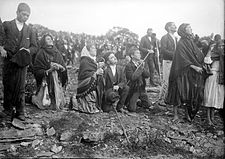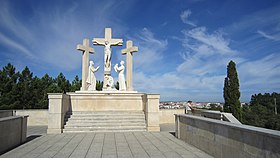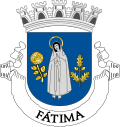Fátima, Portugal
Fátima | |
|---|---|
|
From top left to right: The Sanctuary of Our Lady of Fátima, the main avenue in Cova da Iria, the Basilica of the Holy Trinity, house of Francisco and Jacinta Marto in Aljustrel and the Hungarian Calvary in Valinhos. | |
| Coordinates: 39°37′32″N 08°39′57″W / 39.62556°N 8.66583°W | |
| Country | |
| Region | Oeste e Vale do Tejo |
| Intermunic. comm. | Médio Tejo |
| District | Santarém |
| Municipality | Ourém |
| Area | |
• Total | 71.29 km2 (27.53 sq mi) |
| Elevation | 356 m (1,168 ft) |
| Population (2021) | |
• Total | |
| Time zone | UTC+00:00 (WET) |
| • Summer (DST) | UTC+01:00 (WEST) |
| Postal code | 2495 |
| Area code | 249 |
| Patron | Our Lady of Pleasures Our Lady of Fátima |
| Website | www.freguesiadefatima.pt |
Fátima (Portuguese pronunciation: [ˈfatimɐ] ⓘ) is a city in the municipality of Ourém and district of Santarém in the Oeste e Vale do Tejo Region of Portugal, with 71.29 km2 of area and 13,212 inhabitants (2021).[1] The homonymous civil parish encompasses several villages and localities of which the city of Fátima is the largest.
The civil parish has been permanently associated with
History
Name origin
The name of the town and parish is a rendition of the
Marian apparitions and "Sun miracle"
The parish was founded in 1568, when it was annexed by the Collegiate of Ourém (Portuguese: Colegiada de Ourém). For centuries, most of the villagers kept herds of sheep and depended on subsistence farming.[5]
Since the 18th century, Fátima has been associated with events related to Marian apparitions. The first supposed apparition dates back to the mid 18th century in Ortiga, now a quarter of Fátima, when, according to popular belief, the Virgin Mary appeared to a young, mute shepherdess and asked for one of her sheep, causing the girl to speak in response. This event supposedly incited the creation of the Sanctuary of Our Lady of Ortiga in 1758, which, in 1801, prompted Pope Pius VII to grant an indulgence to all pilgrims visiting the Marian shrine.[6]
Later in the early 20th century, a similar event took place in which three local children, Lúcia dos Santos and her cousins, Francisco and Jacinta Marto, purportedly saw visions of a woman known as Our Lady of Fátima, since believed by the Catholic Church to be the Virgin Mary. On 13 May 1917, whilst guarding their families' sheep in the Cova da Iria, the children first claimed to have seen an apparition of a "lady dressed in white" and shining with a bright light.[7][5]



The three shepherd children were born in Aljustrel, a small hamlet about 1 kilometre (0.62 mi) from Fátima.[8] To the west, near Aljustrel, is Loca do Cabeço, a smaller agglomeration of rocky outcroppings where, in 1916, an angel appeared twice to the three children.[8] The children claimed to have seen the Marian apparition on six occasions; they said the last would be 13 October 1917.[5] An estimated 70,000 pilgrims went to the site for the last prophesied apparition in October. Some of them reported what has been referred to as the Miracle of the Sun, when some observers reported it appeared to be behaving unusually.[7][5]
The local bishop investigated the events and determined that the apparitions were worthy of belief. The site was marked by a cross erected by locals. In 1918 they built a small chapel of rock and limestone and covered in tile. It was 3.3 metres (11 ft) by 2.8 metres (9.2 ft) length, and 2.85 metres (9.4 ft) height. It became a centre for Marian devotion, receiving names such as a fé de Fátima, cidade da Paz ("the faith of Fátima, City of Peace"), or Terra de Milagres e Aparições ("Land of Miracles and Apparitions").[5] The focus of Fatima as a place for peace pilgrimages developed in World War II when Lucia's messages were linked to the conflict.[9]
The chapel has since been enclosed within a large basilica and sanctuary, part of a complex including a hotel and other facilities.[7][5] In 1930, the statue of Our Lady in the Chapel of Apparitions was crowned by the Vatican.
Francisco died in 1919 and Jacinta in 1920, during the international Spanish flu pandemic. Lucia dos Santos became a nun and lived until 2005.[7][5] The two who died young were beatified on 13 May 2000 by Pope John Paul II,[7] and were canonised by Pope Francis on 13 May 2017, the hundredth anniversary of the first apparition.[10]
Subsequent development
The construction of the sanctuary and the steady visits by pilgrims stimulated local development. In addition to construction of a large shrine, basilica, and sanctuary, the complex includes a hotel and other facilities. The town of Fátima was elevated to the status of city on 12 July 1997.[8]
In the early 21st century, numerous residents of the parish (primarily from its business sector) worked to have Fátima designated as an independent municipality. The project, led by Júlio Silva, engineer and ex-president of the Junta de Freguesia (Parish Council), was vetoed in July 2003 by President of Portugal Jorge Sampaio.[8]
Geography and climate
Geography

Fátima is located in central west Portugal. It borders São Mamede (Batalha) and Minde (Alcanena) to the southwest, Pedrógão and Chancelaria (Torres Novas) in the east, Atouguia and Nossa Senhora das Misericórdias (Ourém) to the north and Santa Catarina da Serra e Chainça (Leiria) to the northwest.
The parish contains the following localities: Aljustrel, Alvaijar, Amoreira, Boleiros, Casa Velha, Casal Farto, Chã, Charneca, Cova da Iria, Eira da Pedra, Fátima, Giesteira, Lombo da Égua, Maxeira, Moimento, Moita Redonda, Moitas, Montelo, Pederneira, Poço de Soudo, Ramila, Vale de Cavalos and Valinho de Fátima.
Fátima sits on a plateau at approximately 356 metres (1,168 ft)
The soil is characteristically porous which intensifies the already low availability of water in the summer. And even though precipitation in autumn, winter and spring is relatively high, the overall
The trees in this area are primarily dominated by holly oak ( forests are also common in the outskirts of the city.

Climate
Fátima has a
The climate is characterized by heavy precipitation during late autumn and winter, with approximately 1,150 millimetres (45 in) annually, and warm, dry summers. Fátima has considerably more precipitation than other cities nearby in part due to its higher altitude, though precipitation in summer is more or less the same.
In the winter, temperatures range between 13 °C (55 °F) on the daytime and 4 °C (39 °F) at night with January being the coldest month. Humid air masses coming from N/NW that come into contact with the plateau of Fátima are the reason behind the strong rains experienced in the low-sun half of the year. Light frosts are typical from late December to mid February and temperatures can get down to −4 °C (25 °F) occasionally.
Summer temperatures range between 27 °C (81 °F) at day and 15 °C (59 °F) at night, but are rather unpredictable, as influences from the
The city has about 2600 hours of annual sunshine. Snow is rare, the last significant events being in 2016 and 2013 both on 27 February.
| Climate data for Boleiros, Fátima, altitude: 320 m (1,050 ft), 1984-2002 | |||||||||||||
|---|---|---|---|---|---|---|---|---|---|---|---|---|---|
| Month | Jan | Feb | Mar | Apr | May | Jun | Jul | Aug | Sep | Oct | Nov | Dec | Year |
| Average precipitation mm (inches) | 173.7 (6.84) |
124.3 (4.89) |
85.1 (3.35) |
107.1 (4.22) |
88.2 (3.47) |
30.7 (1.21) |
7.1 (0.28) |
7.8 (0.31) |
62.5 (2.46) |
128.5 (5.06) |
160.2 (6.31) |
175.7 (6.92) |
1,150.9 (45.32) |
| Source: Portuguese Environment Agency[11] | |||||||||||||
Twin towns – Sister cities
Fátima is
Economy

The economy of the city relies on religious tourism because the world devotion through Our Lady of Fátima attracts millions of Christian pilgrims. The locals have numerous shops and stalls devoted to the sale of religious articles and souvenirs. In addition, services for tourists, hotels, restaurants and other retail also benefit from the visitors. Other economic activities in the region include: marble sculpturing, saw-milling, carpentry, civil construction, commerce, and services.[13]
Papal visits



- May 1967 – Pope Paul VI
- May 1982 – Pope John Paul II (1st visit)
- May 1991 – Pope John Paul II (2nd visit)
- May 2000 – Pope John Paul II (3rd visit)
- May 2010 – Pope Benedict XVI
- May 2017 – Pope Francis (1st visit)
- August 2023 – Pope Francis (2nd visit)
Architecture
Civic
- Bus station of Fátima (Portuguese: Estação Rodoviária de Fátima)
- Cistern of Gaiola (Portuguese: Cisterna em Gaiola)
- Cistern of Ramila (Portuguese: Cisterna em Ramila)
- Cistern of Capuchos (Portuguese: Cisterna dos Capuchos)
- Civil Parish Building of Fátima (Portuguese: Junta de Freguesia de Fátima)
- Fountain of Alveijar (Portuguese: Fonte do Alveijar)
- Fountain of Lameira (Portuguese: Fonte da Lameira)
- Fountain of Soudo Well (Portuguese: Fonte em Poço de Soudo)
- Fountain of Vale da Pena (Portuguese: Fonte do Vale da Pena)
- Fountain New (Portuguese: Fonte Nova)
- House of Casal Farto (Portuguese: Casa de Casal Farto)
- Main avenue of Fátima (Portuguese: Avenida de Dom José Alves Correia da Silva)
- Mills of Fátima (Portuguese: Moinhos de Fátima)
- Mills of Fazarga (Portuguese: Moinhos da Fazarga)
- Mills of Giesteira (Portuguese: Moinhos da Giesteira)
- Mill of Ortiga (Portuguese: Moinho da Ortiga)
- Monument of the Three Little Shepherds (Portuguese: Monumento dos Pastorinhos - Rotunda Sul de Fátima)
- Old mill of Ramila (Portuguese: Moinho Arruinado em Ramila)
- Olive Oil Press in Estrada das Matas (Portuguese: Lagar de azeite na Estrada das Matas)
- Porch House with Sundial (Portuguese: Casa Alpendrada com relógio de Sol em Casal Farto)
- Residence of Francisco and Jacinta Marto, visionaries of Fátima (Portuguese: Casa de Francisco e Jacinta Marto, videntes de Fátima)
- Residence of Lúcia dos Santos (Portuguese: Casa de Lúcia dos Santos, vidente de Fátima)
- Threshing-floor of Ramila (Portuguese: Eira em Ramila)
Religious





- Chapel of Casal Farto (Portuguese: Capela de Casal Farto)
- Chapel of Lombo de Égua (Portuguese: Capela de Lombo de Égua)
- Chapel of Our Lady of Conception (Portuguese: Capela da Amoreira/Capela de Nossa Senhora da Conceição)
- Church of Our Lady of Livramento (Portuguese: Capela de Boleiros/Igreja de Nossa Senhora do Livramento)
- Church of Saint Anthony (Portuguese: Igreja Paroquial de Fátima / Igreja Paroquial de Santo António)
- Lúcia dos Santos. The Church of the Holy Trinity, one of the largest churches in the world, was built on the other side of the esplanade in the early 21st century.
- Sanctuary of Fátima (Portuguese: Santuário de Fátima)
- Chapel of the Apparitions (Portuguese: Capelinha das Aparições)
- Basilica of Our Lady of the Rosary (Portuguese: Basílica de Nossa Senhora do Rosário)
- Sanctuary of Our Lady of Ortiga (Portuguese: Santuário de Nossa Senhora da Ortiga)
- Parochial church of Fátima (Portuguese: Igreja Paroquial de Fátima)
- Stations of the Cross of Valinhos (Portuguese: Via Sacra dos Valinhos)
- Statues of the Angel of Portugal (Portuguese: Estátua do Anjo de Portugal), at the Loca do Cabeço and at the Poço do Arneiro (well of Arneiro) in Aljustrel
- Chapel of Saint Stephen of Hungary (Portuguese: Capela de Santo Estevão)
- Byzantine Chapel of the Holy Ukrainian Greek Catholiccommunity.
Culture
The Sanctuary of Our Lady of Fátima, in Cova da Iria, is the principal focus of all visitors. Annually, at least five million Catholic pilgrims fill the country roads leading to the Marian shrine. Numbers can reach hundreds of the thousands on 13 May and 13 October, the most significant dates of the apparitions in Fátima.[14]
Sports
Fátima's major sports club is the Sport Center of Fátima, currently in Portuguese football's second tier, the LigaPro.
See also
References
- ^ "Censos 2021: Resultados Provisórios". censos.ine.pt. Archived from the original on 26 December 2021. Retrieved 18 December 2021.
- ^ "Religion moves 330 million tourists a year and six million go to Fátima" Archived 5 December 2018 at the Wayback Machine, Diário de Notícias, 19 February 2017.
- ^ "Fátima expects to receive 8 million visitors in 2017" Archived 5 December 2018 at the Wayback Machine, in Sapo20, 15 December 2016.
- ^ "How Fatima Came To Be". www.holymary.info. Archived from the original on 15 January 2016. Retrieved 15 February 2016.
- ^ a b c d e f g Junta de Freguesia de Fátima, ed. (2018), History, Fátima (Ourém), Portugal, archived from the original on 23 December 2017, retrieved 2 February 2018
{{citation}}: CS1 maint: location missing publisher (link) - ^ "Peregrinações à Nossa Senhora da Ortiga, Fátima e a epidemia de "aparições"" (in European Portuguese). Observador. Archived from the original on 27 July 2021. Retrieved 27 July 2021.
- ^ ISBN 978-0385028691
- ^ a b c d e f g Junta Freguesia, ed. (2011), Caracterização (in Portuguese), Fátima (Ourém), Portugal, archived from the original on 13 June 2017, retrieved 12 October 2012
{{citation}}: CS1 maint: location missing publisher (link) - S2CID 246695850.
- ^ "Pope Francis canonises two children at Portugal's Fatima shrine". BBC. 13 May 2017. Archived from the original on 13 May 2017. Retrieved 13 May 2017.
- ^ "Boleiros (16F/03U), 1984-2002". APA. Archived from the original on 10 June 2021. Retrieved 23 December 2020.
- ^ a b c d e "Association of Towns awarded The Europe Prize". czestochowa.um.gov.pl. Archived from the original on 21 August 2008. Retrieved 10 October 2009.
- ^ "Caraterização | Sobre Fátima". Junta de Freguesia de Fátima (in Portuguese). Archived from the original on 13 October 2023. Retrieved 23 July 2021.
- ^ Trudy Ring (1996), p.245
- Ring, Trudy (1996), International Dictionary of Historic Places, ISBN 978-1-884964-02-2
External links
- City Hall of Fátima – Official website
- Sanctuary of Fátima – Online transmissions
- Pilgrims of Fátima – Official website
- Fatima in Sister Lucia's own words – Free online version of the memoir book written by Sister Lucia dos SantosLúcia de Jesus Rosa dos Santos, OCD
- The True Story of Fatima – Free online version of the book written by Father John de Marchi, IMC
- Video documentary: Portugal in 150 seconds: Fátima










